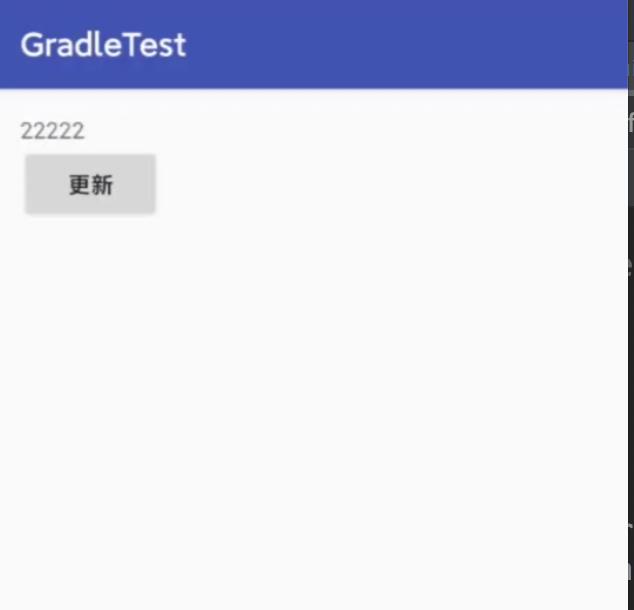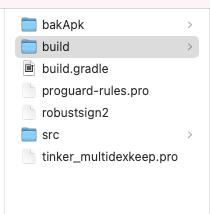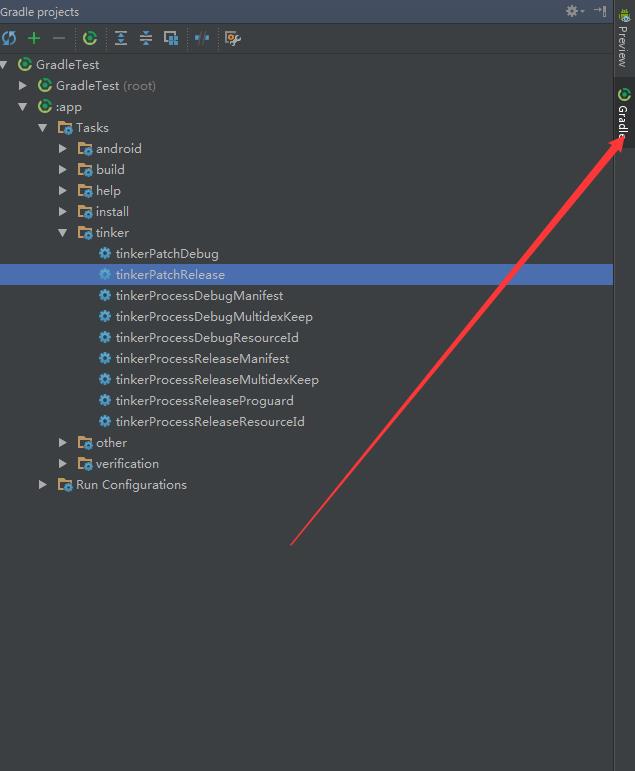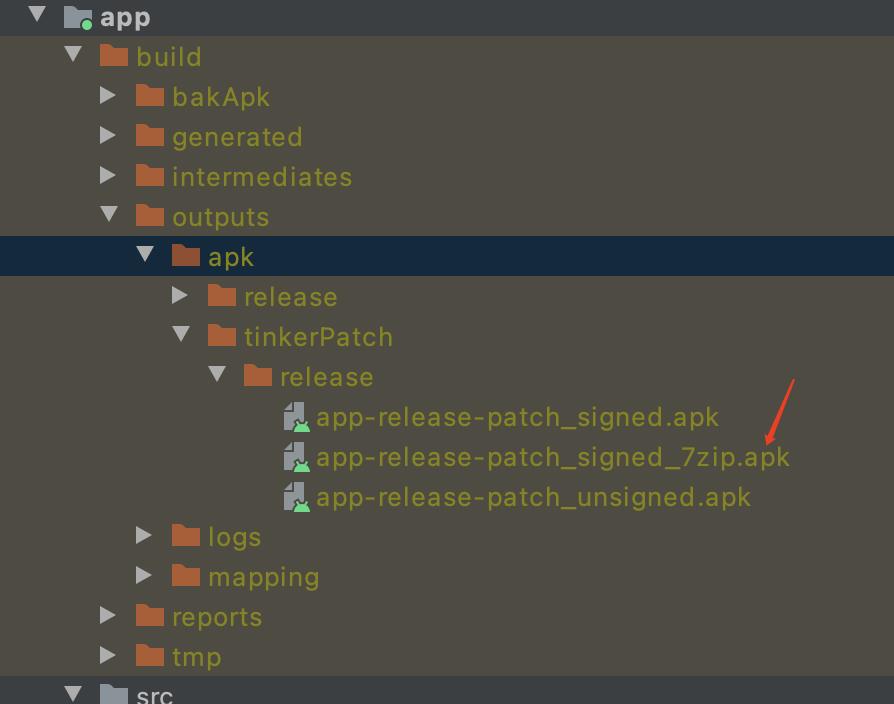tinker热修复gradle接入
Posted BigSweetee
tags:
篇首语:本文由小常识网(cha138.com)小编为大家整理,主要介绍了tinker热修复gradle接入相关的知识,希望对你有一定的参考价值。
本篇文章已授权微信公众号 guolin_blog (郭霖)独家发布
2021-04-29更新,最近在复习热修复,发现我的老代码不行了,所以把这篇文章更新一下
本篇是gradle接入
tinker的github网址为tinker
我使用的最新版本为TINKER_VERSION=1.9.14.12
下面开始更新新版的代码
在peoject的build中配置如下
buildscript {
repositories {
mavenLocal()
jcenter()
google()
}
dependencies {
classpath 'com.android.tools.build:gradle:3.5.3'
classpath("com.tencent.tinker:tinker-patch-gradle-plugin:${TINKER_VERSION}") {
changing = TINKER_VERSION?.endsWith("-SNAPSHOT")
exclude group: 'com.android.tools.build', module: 'gradle'
}
}
configurations.all {
it.resolutionStrategy.cacheDynamicVersionsFor(5, 'minutes')
it.resolutionStrategy.cacheChangingModulesFor(0, 'seconds')
}
}
allprojects {
repositories {
mavenLocal()
jcenter()
google()
}
}
TINKER_VERSION需要在gradle.properties中进行配置我的gradle.properties文件内容为
TINKER_VERSION=1.9.14.12
android.useAndroidX=true
android.enableJetifier=true
android.enableR8 = false
我在用老的项目测试最新版本的tinker的时候,发现R8打补丁包的时候总是报错,所以我把R8静止掉了
接下来是配置app的build,官方文档推荐我们使用他们demo里面的配置
build.gradle
于是我全部copy了过来,不过里面的几个地方还是需要修改的
首先先贴上全部的
我会在里面写上注释
apply plugin: 'com.android.application'
dependencies {
implementation fileTree(dir: 'libs', include: ['*.jar'])
testImplementation 'junit:junit:4.12'
implementation "androidx.appcompat:appcompat:1.1.0"
api("com.tencent.tinker:tinker-android-lib:${TINKER_VERSION}") { changing = true }
// Maven local cannot handle transist dependencies.
implementation("com.tencent.tinker:tinker-android-loader:${TINKER_VERSION}") { changing = true }
annotationProcessor("com.tencent.tinker:tinker-android-anno:${TINKER_VERSION}") { changing = true }
compileOnly("com.tencent.tinker:tinker-android-anno:${TINKER_VERSION}") { changing = true }
compileOnly("com.tencent.tinker:tinker-android-anno-support:${TINKER_VERSION}") { changing = true }
implementation "androidx.multidex:multidex:2.0.1"
}
def gitSha() {
try {
String gitRev = 'git rev-parse --short HEAD'.execute(null, project.rootDir).text.trim()
if (gitRev == null) {
throw new GradleException("can't get git rev, you should add git to system path or just input test value, such as 'testTinkerId'")
}
return gitRev
} catch (Exception e) {
throw new GradleException("can't get git rev, you should add git to system path or just input test value, such as 'testTinkerId'")
}
}
def javaVersion = JavaVersion.VERSION_1_7
android {
compileSdkVersion 28
buildToolsVersion '28.0.3'
compileOptions {
sourceCompatibility javaVersion
targetCompatibility javaVersion
}
//recommend
dexOptions {
jumboMode = true
}
signingConfigs {
debug {
keyAlias "key0"
keyPassword "123456"
storeFile file('robustsign2')
storePassword "123456"
}
release {
keyAlias "key0"
keyPassword "123456"
storeFile file('robustsign2')
storePassword "123456"
}
}
defaultConfig {
applicationId "tinker.sample.android"
minSdkVersion 14
targetSdkVersion 26
versionCode 1
versionName "1.0.0"
/**
* you can use multiDex and install it in your ApplicationLifeCycle implement
*/
multiDexEnabled true
multiDexKeepProguard file("tinker_multidexkeep.pro")
/**
* buildConfig can change during patch!
* we can use the newly value when patch
*/
buildConfigField "String", "MESSAGE", "\\"I am the base apk\\""
// buildConfigField "String", "MESSAGE", "\\"I am the patch apk\\""
/**
* client version would update with patch
* so we can get the newly git version easily!
*/
buildConfigField "String", "TINKER_ID", "\\"${getTinkerIdValue()}\\""
buildConfigField "String", "PLATFORM", "\\"all\\""
}
// aaptOptions{
// additionalParameters "--emit-ids", "${project.file('public.txt')}"
// cruncherEnabled false
// }
// //use to test flavors support
// productFlavors {
// flavor1 {
// applicationId 'tinker.sample.android.flavor1'
// }
//
// flavor2 {
// applicationId 'tinker.sample.android.flavor2'
// }
// }
buildTypes {
release {
minifyEnabled true
signingConfig signingConfigs.release
proguardFiles getDefaultProguardFile('proguard-android.txt'), project.file('proguard-rules.pro')
}
debug {
debuggable true
minifyEnabled false
signingConfig signingConfigs.debug
}
}
sourceSets {
main {
jniLibs.srcDirs = ['libs']
}
}
packagingOptions {
exclude "/META-INF/**"
}
}
def bakPath = file("${buildDir}/bakApk/")
/**
* you can use assembleRelease to build you base apk
* use tinkerPatchRelease -POLD_APK= -PAPPLY_MAPPING= -PAPPLY_RESOURCE= to build patch
* add apk from the build/bakApk
*/
ext {
//for some reason, you may want to ignore tinkerBuild, such as instant run debug build?
tinkerEnabled = true
//for normal build
//old apk file to build patch apk
tinkerOldApkPath = "${bakPath}/app-release-0429-15-58-52.apk"
//proguard mapping file to build patch apk
tinkerApplyMappingPath = "${bakPath}/app-release-0429-15-58-52-mapping.txt"
//resource R.txt to build patch apk, must input if there is resource changed
tinkerApplyResourcePath = "${bakPath}/app-release-0429-15-58-52-R.txt"
//only use for build all flavor, if not, just ignore this field
tinkerBuildFlavorDirectory = "${bakPath}/app-1018-17-32-47"
}
def getOldApkPath() {
return hasProperty("OLD_APK") ? OLD_APK : ext.tinkerOldApkPath
}
def getApplyMappingPath() {
return hasProperty("APPLY_MAPPING") ? APPLY_MAPPING : ext.tinkerApplyMappingPath
}
def getApplyResourceMappingPath() {
return hasProperty("APPLY_RESOURCE") ? APPLY_RESOURCE : ext.tinkerApplyResourcePath
}
def getTinkerIdValue() {
return hasProperty("TINKER_ID") ? TINKER_ID : gitSha()
}
def buildWithTinker() {
return hasProperty("TINKER_ENABLE") ? Boolean.parseBoolean(TINKER_ENABLE) : ext.tinkerEnabled
}
def getTinkerBuildFlavorDirectory() {
return ext.tinkerBuildFlavorDirectory
}
if (buildWithTinker()) {
apply plugin: 'com.tencent.tinker.patch'
tinkerPatch {
/**
* necessary,default 'null'
* the old apk path, use to diff with the new apk to build
* add apk from the build/bakApk
*/
oldApk = getOldApkPath()
/**
* optional,default 'false'
* there are some cases we may get some warnings
* if ignoreWarning is true, we would just assert the patch process
* case 1: minSdkVersion is below 14, but you are using dexMode with raw.
* it must be crash when load.
* case 2: newly added Android Component in AndroidManifest.xml,
* it must be crash when load.
* case 3: loader classes in dex.loader{} are not keep in the main dex,
* it must be let tinker not work.
* case 4: loader classes in dex.loader{} changes,
* loader classes is ues to load patch dex. it is useless to change them.
* it won't crash, but these changes can't effect. you may ignore it
* case 5: resources.arsc has changed, but we don't use applyResourceMapping to build
*/
ignoreWarning = false
/**
* optional,default 'true'
* whether sign the patch file
* if not, you must do yourself. otherwise it can't check success during the patch loading
* we will use the sign config with your build type
*/
useSign = true
/**
* optional,default 'true'
* whether use tinker to build
*/
tinkerEnable = buildWithTinker()
/**
* Warning, applyMapping will affect the normal android build!
*/
buildConfig {
/**
* optional,default 'null'
* if we use tinkerPatch to build the patch apk, you'd better to apply the old
* apk mapping file if minifyEnabled is enable!
* Warning:
* you must be careful that it will affect the normal assemble build!
*/
applyMapping = getApplyMappingPath()
/**
* optional,default 'null'
* It is nice to keep the resource id from R.txt file to reduce java changes
*/
applyResourceMapping = getApplyResourceMappingPath()
/**
* necessary,default 'null'
* because we don't want to check the base apk with md5 in the runtime(it is slow)
* tinkerId is use to identify the unique base apk when the patch is tried to apply.
* we can use git rev, svn rev or simply versionCode.
* we will gen the tinkerId in your manifest automatic
*/
tinkerId = "1.0"
/**
* if keepDexApply is true, class in which dex refer to the old apk.
* open this can reduce the dex diff file size.
*/
keepDexApply = false
/**
* optional, default 'false'
* Whether tinker should treat the base apk as the one being protected by app
* protection tools.
* If this attribute is true, the generated patch package will contain a
* dex including all changed classes instead of any dexdiff patch-info files.
*/
isProtectedApp = false
/**
* optional, default 'false'
* Whether tinker should support component hotplug (add new component dynamically).
* If this attribute is true, the component added in new apk will be available after
* patch is successfully loaded. Otherwise an error would be announced when generating patch
* on compile-time.
*
* <b>Notice that currently this feature is incubating and only support NON-EXPORTED Activity</b>
*/
supportHotplugComponent = false
}
dex {
/**
* optional,default 'jar'
* only can be 'raw' or 'jar'. for raw, we would keep its original format
* for jar, we would repack dexes with zip format.
* if you want to support below 14, you must use jar
* or you want to save rom or check quicker, you can use raw mode also
*/
dexMode = "jar"
/**
* necessary,default '[]'
* what dexes in apk are expected to deal with tinkerPatch
* it support * or ? pattern.
*/
pattern = ["classes*.dex",
"assets/secondary-dex-?.jar"]
/**
* necessary,default '[]'
* Warning, it is very very important, loader classes can't change with patch.
* thus, they will be removed from patch dexes.
* you must put the following class into main dex.
* Simply, you should add your own application {@code tinker.sample.android.SampleApplication}
* own tinkerLoader, and the classes you use in them
*
*/
loader = [
//use sample, let BaseBuildInfo unchangeable with tinker
"tinker.sample.android.app.BaseBuildInfo"
]
}
lib {
/**
* optional,default '[]'
* what library in apk are expected to deal with tinkerPatch
* it support * or ? pattern.
* for library in assets, we would just recover them in the patch directory
* you can get them in TinkerLoadResult with Tinker
*/
pattern = ["lib/*/*.so"]
}
res {
/**
* optional,default '[]'
* what resource in apk are expected to deal with tinkerPatch
* it support * or ? pattern.
* you must include all your resources in apk here,
* otherwise, they won't repack in the new apk resources.
*/
pattern = ["res/*", "assets/*", "resources.arsc", "AndroidManifest.xml"]
/**
* optional,default '[]'
* the resource file exclude patterns, ignore add, delete or modify resource change
* it support * or ? pattern.
* Warning, we can only use for files no relative with resources.arsc
*/
ignoreChange = ["assets/sample_meta.txt"]
/**
* default 100kb
* for modify resource, if it is larger than 'largeModSize'
* we would like to use bsdiff algorithm to reduce patch file size
*/
largeModSize = 100
}
packageConfig {
/**
* optional,default 'TINKER_ID, TINKER_ID_VALUE' 'NEW_TINKER_ID, NEW_TINKER_ID_VALUE'
* package meta file gen. path is assets/package_meta.txt in patch file
* you can use securityCheck.getPackageProperties() in your ownPackageCheck method
* or TinkerLoadResult.getPackageConfigByName
* we will get the TINKER_ID from the old apk manifest for you automatic,
* other config files (such as patchMessage below)is not necessary
*/
configField("patchMessage", "tinker is sample to use")
/**
* just a sample case, you can use such as sdkVersion, brand, channel...
* you can parse it in the SamplePatchListener.
* Then you can use patch conditional!
*/
configField("platform", "all")
/**
* patch version via packageConfig
*/
configField("patchVersion", "1.0")
}
//or you can add config filed outside, or get meta value from old apk
//project.tinkerPatch.packageConfig.configField("test1", project.tinkerPatch.packageConfig.getMetaDataFromOldApk("Test"))
//project.tinkerPatch.packageConfig.configField("test2", "sample")
/**
* if you don't use zipArtifact or path, we just use 7za to try
*/
sevenZip {
/**
* optional,default '7za'
* the 7zip artifact path, it will use the right 7za with your platform
*/
zipArtifact = "com.tencent.mm:SevenZip:1.1.10"
/**
* optional,default '7za'
* you can specify the 7za path yourself, it will overwrite the zipArtifact value
*/
// path = "/usr/local/bin/7za"
}
}
List<String> flavors = new ArrayList<>();
project.android.productFlavors.each { flavor ->
flavors.add(flavor.name)
}
boolean hasFlavors = flavors.size() > 0
def date = new Date().format("MMdd-HH-mm-ss")
/**
* bak apk and mapping
*/
android.applicationVariants.all { variant ->
/**
* task type, you want to bak
*/
def taskName = variant.name
tasks.all {
if ("assemble${taskName.capitalize()}".equalsIgnoreCase(it.name)) {
it.doLast {
copy {
def fileNamePrefix = "${project.name}-${variant.baseName}"
def newFileNamePrefix = hasFlavors ? "${fileNamePrefix}" : "${fileNamePrefix}-${date}"
def destPath = hasFlavors ? file("${bakPath}/${project.name}-${date}/${variant.flavorName}") : bakPath
if (variant.metaClass.hasProperty(variant, 'packageApplicationProvider')) {
def packageAndroidArtifact = variant.packageApplicationProvider.get()
if (packageAndroidArtifact != null) {
try {
from new File(packageAndroidArtifact.outputDirectory.getAsFile().get(), variant.outputs.first().apkData.outputFileName)
} catch (Exception e) {
from new File(packageAndroidArtifact.outputDirectory, variant.outputs.first().apkData.outputFileName)
}
} else {
from variant.outputs.first().mainOutputFile.outputFile
}
} else {
from variant.outputs.first().outputFile
}
into destPath
rename { String fileName ->
fileName.replace("${fileNamePrefix}.apk", "${newFileNamePrefix}.apk")
}
def dirName = variant.dirName
if (hasFlavors) {
dirName = taskName
}
from "${buildDir}/outputs/mapping/${dirName}/mapping.txt"
into destPath
rename { String fileName ->
fileName.replace("mapping.txt", "${newFileNamePrefix}-mapping.txt")
}
from "${buildDir}/intermediates/symbols/${dirName}/R.txt"
from "${buildDir}/intermediates/symbol_list/${dirName}/R.txt"
from "${buildDir}/intermediates/runtime_symbol_list/${dirName}/R.txt"
into destPath
rename { String fileName ->
fileName.replace("R.txt", "${newFileNamePrefix}-R.txt")
}
}
}
}
}
}
project.afterEvaluate {
//sample use for build all flavor for one time
if (hasFlavors) {
task(tinkerPatchAllFlavorRelease) {
group = 'tinker'
def originOldPath = getTinkerBuildFlavorDirectory()
for (String flavor : flavors) {
def tinkerTask = tasks.getByName("tinkerPatch${flavor.capitalize()}Release")
dependsOn tinkerTask
def preAssembleTask = tasks.getByName("process${flavor.capitalize()}ReleaseManifest")
preAssembleTask.doFirst {
String flavorName = preAssembleTask.name.substring(7, 8).toLowerCase() + preAssembleTask.name.substring(8, preAssembleTask.name.length() - 15)
project.tinkerPatch.oldApk = "${originOldPath}/${flavorName}/${project.name}-${flavorName}-release.apk"
project.tinkerPatch.buildConfig.applyMapping = "${originOldPath}/${flavorName}/${project.name}-${flavorName}-release-mapping.txt"
project.tinkerPatch.buildConfig.applyResourceMapping = "${originOldPath}/${flavorName}/${project.name}-${flavorName}-release-R.txt"
}
}
}
task(tinkerPatchAllFlavorDebug) {
group = 'tinker'
def originOldPath = getTinkerBuildFlavorDirectory()
for (String flavor : flavors) {
def tinkerTask = tasks.getByName("tinkerPatch${flavor.capitalize()}Debug")
dependsOn tinkerTask
def preAssembleTask = tasks.getByName("process${flavor.capitalize()}DebugManifest")
preAssembleTask.doFirst {
String flavorName = preAssembleTask.name.substring(7, 8).toLowerCase() + preAssembleTask.name.substring(8, preAssembleTask.name.length() - 13)
project.tinkerPatch.oldApk = "${originOldPath}/${flavorName}/${project.name}-${flavorName}-debug.apk"
project.tinkerPatch.buildConfig.applyMapping = "${originOldPath}/${flavorName}/${project.name}-${flavorName}-debug-mapping.txt"
project.tinkerPatch.buildConfig.applyResourceMapping = "${originOldPath}/${flavorName}/${project.name}-${flavorName}-debug-R.txt"
}
}
}
}
}
}
task sortPublicTxt() {
doLast {
File originalFile = project.file("public.txt")
File sortedFile = project.file("public_sort.txt")
List<String> sortedLines = new ArrayList<>()
originalFile.eachLine {
sortedLines.add(it)
}
Collections.sort(sortedLines)
sortedFile.delete()
sortedLines.each {
sortedFile.append("${it}\\n")
}
}
}
主要修改了下面几个地方
def getTinkerIdValue() {
hasProperty("TINKER_ID") ? TINKER_ID : gitSha()
}
官方文档默认是将git提交的记录作为think_id记录下来,这里我不需要,所以我改成下图
def getTinkerIdValue() {
return "1.0"
}
接下来修改自己的签名文件,我这里配置的文件路径在APP的目录下面账号密码如下,是我在写robustdemo的时候生成的
//配置自己的签名文件,签名文件的生成和导入可以去百度,本篇不讲解
signingConfigs {
debug {
keyAlias "key0"
keyPassword "123456"
storeFile file('robustsign2')
storePassword "123456"
}
release {
keyAlias "key0"
keyPassword "123456"
storeFile file('robustsign2')
storePassword "123456"
}
}
buildTypes {
release {
minifyEnabled true
signingConfig signingConfigs.release
proguardFiles getDefaultProguardFile('proguard-android.txt'), project.file('proguard-rules.pro')
}
debug {
debuggable true
minifyEnabled false
signingConfig signingConfigs.debug
}
}
配置完上面之后,build就配置好了,接下来配置application
先上代码
package com.anlaiye.swt.gradletest;
import android.annotation.TargetApi;
import android.app.Application;
import android.content.Context;
import android.content.Intent;
import android.os.Build;
import androidx.multidex.MultiDex;
import com.tencent.tinker.anno.DefaultLifeCycle;
import com.tencent.tinker.entry.ApplicationLike;
import com.tencent.tinker.lib.tinker.TinkerInstaller;
import com.tencent.tinker.loader.shareutil.ShareConstants;
@DefaultLifeCycle(application = "tinker.sample.android.app.SampleApplication",
flags = ShareConstants.TINKER_ENABLE_ALL,
loadVerifyFlag = false)
public class SimpleTinkerInApplicationLike extends ApplicationLike {
public SimpleTinkerInApplicationLike(Application application, int tinkerFlags, boolean tinkerLoadVerifyFlag, long applicationStartElapsedTime, long applicationStartMillisTime, Intent tinkerResultIntent) {
super(application, tinkerFlags, tinkerLoadVerifyFlag, applicationStartElapsedTime, applicationStartMillisTime, tinkerResultIntent);
}
@Override
public void onBaseContextAttached(Context base) {
super.onBaseContextAttached(base);
MultiDex.install(base);
TinkerInstaller.install(this);
}
@TargetApi(Build.VERSION_CODES.ICE_CREAM_SANDWICH)
public void registerActivityLifecycleCallbacks(Application.ActivityLifecycleCallbacks callback) {
getApplication().registerActivityLifecycleCallbacks(callback);
}
}
这个application官网有提供的,也可以copy我的,SimpleTinkerInApplicationLike 并不是一个application真正的application是@DefaultLifeCycle里面的tinker.sample.android.app.SampleApplication
所以在androidmanifest中配置application的name
android:name="tinker.sample.android.app.SampleApplication"
打开SampleApplication可以看到其实会定位到我们的application
public class SampleApplication extends TinkerApplication {
public SampleApplication() {
super(15, "com.anlaiye.swt.gradletest.SimpleTinkerInApplicationLike", "com.tencent.tinker.loader.TinkerLoader", false, false);
}
}
同时配置读取sd卡的权限
接下来测试
<?xml version="1.0" encoding="utf-8"?>
<RelativeLayout
xmlns:android="http://schemas.android.com/apk/res/android"
xmlns:tools="http://schemas.android.com/tools"
android:id="@+id/activity_main"
android:layout_width="match_parent"
android:layout_height="match_parent"
android:paddingBottom="@dimen/activity_vertical_margin"
android:paddingLeft="@dimen/activity_horizontal_margin"
android:paddingRight="@dimen/activity_horizontal_margin"
android:paddingTop="@dimen/activity_vertical_margin"
tools:context="com.anlaiye.swt.gradletest.MainActivity">
<TextView
android:id="@+id/tv"
android:layout_width="wrap_content"
android:layout_height="wrap_content"
android:text="22222"/>
<Button
android:layout_below="@+id/tv"
android:onClick="loadPath"
android:layout_width="wrap_content"
android:layout_height="wrap_content"
android:text="更新"/>
</RelativeLayout>
第一次我设置textview的值是22222
然后设置按钮调用onclick
package com.anlaiye.swt.gradletest;
import android.Manifest;
import android.content.pm.PackageManager;
import android.os.Build;
import android.os.Bundle;
import android.os.Environment;
import android.util.Log;
import android.view.View;
import android.widget.Toast;
import androidx.appcompat.app.AppCompatActivity;
import androidx.core.app.ActivityCompat;
import androidx.core.content.ContextCompat;
import com.tencent.tinker.lib.tinker.TinkerInstaller;
import java.io.File;
public class MainActivity extends AppCompatActivity {
public static final int MY_PERMISSIONS_REQUEST_READ_CONTACTS = 1;
@Override
protected void onCreate(Bundle savedInstanceState) {
super.onCreate(savedInstanceState);
setContentView(R.layout.activity_main);
if (!hasRequiredPermissions()) {
ActivityCompat.requestPermissions(this, new String[]{Manifest.permission.READ_EXTERNAL_STORAGE}, 0);
}
}
private boolean hasRequiredPermissions() {
if (Build.VERSION.SDK_INT >= 16) {
final int res = ContextCompat.checkSelfPermission(this.getApplicationContext(), Manifest.permission.READ_EXTERNAL_STORAGE);
return res == PackageManager.PERMISSION_GRANTED;
} else {
// When SDK_INT is below 16, READ_EXTERNAL_STORAGE will also be granted if WRITE_EXTERNAL_STORAGE is granted.
final int res = ContextCompat.checkSelfPermission(this.getApplicationContext(), Manifest.permission.WRITE_EXTERNAL_STORAGE);
return res == PackageManager.PERMISSION_GRANTED;
}
}
//加载补丁
public void loadPath(View view) {
requestPermi();
}
public void loadApk() {
String path = Environment.getExternalStorageDirectory().getAbsolutePath() + "/app-release-patch_signed_7zip.apk";
File file = new File(path);
if (file.exists()) {
Toast.makeText(this, "补丁已经存在", Toast.LENGTH_SHORT).show();
TinkerInstaller.onReceiveUpgradePatch(getApplicationContext(), path);
Log.d("swy", path);
} else {
Toast.makeText(this, "补丁已经不存在", Toast.LENGTH_SHORT).show();
Log.d("swy", path);
}
}
private void requestPermi() {
if (ContextCompat.checkSelfPermission(MainActivity.this,
Manifest.permission.READ_EXTERNAL_STORAGE)
!= PackageManager.PERMISSION_GRANTED) {
// Should we show an explanation?
if (ActivityCompat.shouldShowRequestPermissionRationale(MainActivity.this,
Manifest.permission.READ_EXTERNAL_STORAGE)) {
// Show an expanation to the user *asynchronously* -- don't block
// this thread waiting for the user's response! After the user
// sees the explanation, try again to request the permission.
} else {
// No explanation needed, we can request the permission.
ActivityCompat.requestPermissions(MainActivity.this,
new String[]{Manifest.permission.READ_EXTERNAL_STORAGE},
MY_PERMISSIONS_REQUEST_READ_CONTACTS);
Log.d("swt", "requestPermi: ");
// MY_PERMISSIONS_REQUEST_READ_CONTACTS is an
// app-defined int constant. The callback method gets the
// result of the request.
}
} else {
//有权限直接加载apk
loadApk();
}
}
@Override
public void onRequestPermissionsResult(int requestCode,
String permissions[], int[] grantResults) {
switch (requestCode) {
case MY_PERMISSIONS_REQUEST_READ_CONTACTS: {
// If request is cancelled, the result arrays are empty.
if (grantResults.length > 0
&& grantResults[0] == PackageManager.PERMISSION_GRANTED) {
// permission was granted, yay! Do the
// contacts-related task you need to do.
//权限申请成功加载apk
loadApk();
Log.d("swt", "permissionsuss: ");
} else {
// permission denied, boo! Disable the
// functionality that depends on this permission.
}
return;
}
}
}
}
我是直接运行的release包把这个修改了

然后我运行APP
会生成如下的目录结构

同时界面效果

接下来打开app的build找到ext模块
做如下修改将里面的名字和我们生成apk的名字对应
//老版本的文件所在的位置,大家也可以动态配置,不用每次都在这里修改
ext {
//for some reason, you may want to ignore tinkerBuild, such as instant run debug build?
tinkerEnabled = true
//for normal build
//old apk file to build patch apk
tinkerOldApkPath = "${bakPath}/app-release-0429-16-28-46.apk"
//proguard mapping file to build patch apk
tinkerApplyMappingPath = "${bakPath}/app-release-0429-16-28-46-mapping.txt"
//resource R.txt to build patch apk, must input if there is resource changed
tinkerApplyResourcePath = "${bakPath}/app-release-0429-16-28-46-R.txt"
//only use for build all flavor, if not, just ignore this field
tinkerBuildFlavorDirectory = "${bakPath}/app-1018-17-32-47"
}
接下来修改mainactivity的xml文件把textview改成33333,用来和第一次作区别
注意接下来的这个操作是避免这个错误
app\\build\\intermediates\\tinker_intermediates\\values_backup
接下来把bakapk整个文件夹移出来,移到app的目录下面这样

然后再clean一下,在到app的目录下面生成build文件夹
把bakapk文件夹移进去
然后点击tinker的path命令生成渠道包

生成目录如下

注意箭头所指的文件
我们在onclick中执行的文件名就是这个,这个文件就是我们需要的最终的文件
然后将这个文件导入SD卡的最外层目录
adb push /Users/yanzhe/AndroidStudioProjects/TinkerGradleDemo/app/build/outputs/apk/tinkerPatch/release/app-release-patch_signed_7zip.apk /sdcard
导入成功后
点击更新按钮

textview由22222变成33333
但是应用会闪退一下
好像是和这个issue有关
issue
本篇只是简单的演示了整个流程,整理了一下容易踩得坑,可以优化的地方还有很多,大家可以在这个基础上自行发挥。
总结一下自己碰到的坑,
1,首先没有在gradle.properties中配置tinker_id,会提示错误tinker_id not set!!!
2,debug没有配置 proguardFiles getDefaultProguardFile(‘proguard-android.txt’), ‘proguard-rules.pro’
导入生成的apk一直没有mapping文件,找了半天才发现
最后说下热修复的大概流程
最终我们需要的是一个patch.apk文件,这个文件是通过老apk和新apk对比生成的,
是通过腾讯自研的dex差异算法得出
算法相关的地址在这里
dex算法
新APK和老APK的mapping必须是一致的,所以我们需要把老APK的mapping保存起来,方便新APK与他对比。
这样就能得到最终的patch,然后调用sdk的TinkerInstaller.onReceiveUpgradePatch(getApplicationContext(), path);
这样就实现了热修复的目的
下篇讲解命令行接入
本篇下载地址:
csdn下载地址
http://download.csdn.net/download/qq_15527709/10017530 这是老地址
https://download.csdn.net/download/qq_15527709/18243488 这是新的地址
考虑到现在csdn改版下载代码都需要分了,所以我重新上传了一份到了github
https://github.com/BigSweet/TinkerGradleDemo
以上是关于tinker热修复gradle接入的主要内容,如果未能解决你的问题,请参考以下文章